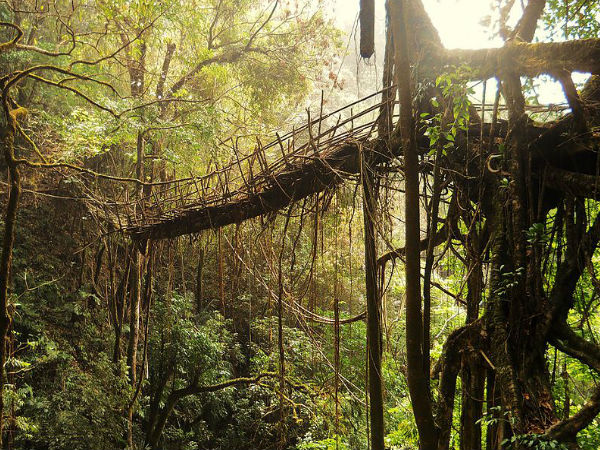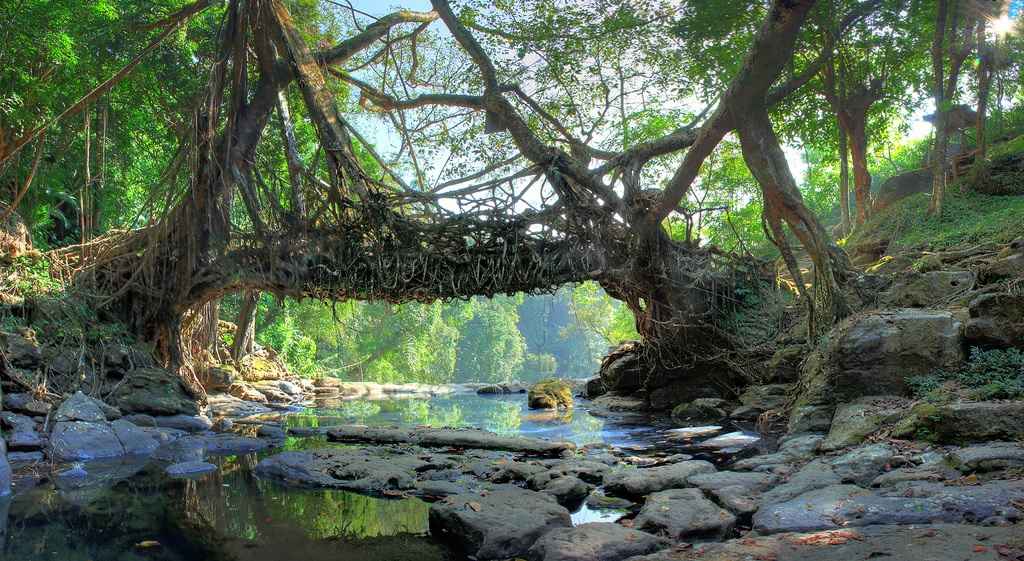The Living Root Bridge, Meghalaya

Roots of the rubber tree (Ficus elastica Roxb.) are the pavements for these natural bridges of near Cherrapunjee in Meghalaya. Strong secondary roots of this rubber tree are manipulated to grow horizontally across rivers. These types of bridges take very long to develop into a firm bridge. These bridges grow to approximately 50 to100 feet long and have strong and deep roots providing a stable foothold. Key advantages of the living root bridges include exceptional structural robustness and resilience, progressive increase in load bearing capacity with time and use, remedial impact on surrounding soil, water and air and grass root community involvement in the growth process across multiple generations.
Ficus elastica is a living biological system.
Imagine about a bridge, which has life. Though it’s very difficult to imagine but in reality it is not impossible as shown by the local villagers of near Cherrapunjee in Meghalaya. They constructed stout, robust bridges over the rivers (Fig.1 ) by interwoven living prop root of Indian Rubber plant (Ficus elastica Roxb.) belonging to the fig family (Moraceae).
different shape and size are constructed by villages near Cherrapunjee in Meghalaya. This hilly terrain is known as one of the wettest place of the world, Mousinram, a adjoining village of this area receives highest rainfall of the world (1,250 cm approx/year). This huge amount of rainwater drains out from this region through numerous streams and rivers which obstructs the communication of the local villagers. It is difficult to construct concrete bridges in these areas due to constrains of transporting the building materials through very poor road network and flash floods in the rivers.
In the far northeast corner of India lies Meghalaya, the “abode of the clouds”. The title is fitting: it’s the wettest state in India. Every year, more than 12 meters of rain pour down upon its lush green mountains and river valleys.
But the abundant rainfall isn’t the only natural wonder drawing tourists to this northeastern “sister” state. Deep in Meghalaya’s forests grow its most famous attractions: the living root bridge.
Crafted by the local Khasi tribes, the bridges are made from the roots of rubber trees. Traditionally, the roots are carefully guided across spaces using the straight trunks of betel nut trees…
There are root bridges scattered all throughout Meghalaya, the bridge in Mawlynnong being the most famous. We chose to skip the crowds and visit the grandest of them all: Umshiang, the double decker bridge in the village of Nongriat, and one of India’s finest offbeat destinations.
Getting there, however, is no simple task. Though visitors’ ways are guided by a newly-minted cement pathway, the journey to Nongriat is a steep one. For information on getting to Cherrapunjee and then to Nongriat, check out our article on how to get to Cherrapunjee.
We didn’t have to stray far to find the main attraction. Umshiang, the double decker living root bridge, is only a stone’s throw away from the village of Nongriat.

